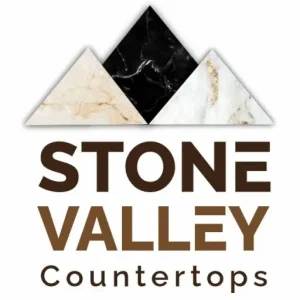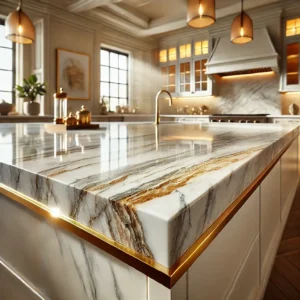Introduction: Why Corian is a Popular Choice
Selecting the right countertop can transform your kitchen or bathroom. One of the most well-known options is Corian, a durable and stylish solid surface material developed by DuPont. This man-made countertop offers a seamless appearance, easy maintenance, and impressive versatility.
Is this the best fit for your home? This guide will help you decide by outlining its advantages, drawbacks, costs, and design possibilities.
For a broader look at countertop materials, check out our guide on different types of countertops.
What is Corian and How is It Made?
Corian is a non-porous, engineered material composed of acrylic resin, natural minerals, and pigments. Unlike natural stone, manufacturers can mold and shape it seamlessly for various applications.
DuPont introduced this countertop alternative in the 1960s, and it remains a popular choice for homeowners and commercial spaces because of its modern look and durability.
Key Advantages of Choosing Corian
Seamless & Sleek Look – The ability to create integrated sinks and backsplashes provides a modern, smooth aesthetic.
Hygienic & Stain Resistant – Its non-porous surface resists bacteria, mold, and mildew, making it a great option for kitchens and bathrooms.
Customizable in Shape & Size – Corian can be thermoformed into curved or unique shapes, offering greater design flexibility.
Easy to Maintain & Repair – Scratches and minor surface damage can be buffed out, unlike quartz or granite, which require professional repairs.
Lightweight Compared to Stone – It’s easier to install than heavier materials like granite or quartz.
Available in Various Colors & Patterns – With a wide range of finishes, you can find the perfect style to match your home.
Potential Drawbacks to Consider
Less Heat Resistant Than Stone – Corian can withstand up to 212°F (100°C) but can be damaged by hot pots and pans. Using trivets is recommended.
More Prone to Scratches – Although durable, it is softer than quartz or granite, making it more susceptible to scratches.
Costs More Than Laminate – While more affordable than high-end stone, Corian is pricier than laminate and some budget-friendly surfaces.
Requires Professional Installation – A seamless look requires specialized tools and expert fabrication.
How Corian Compares to Other Countertops
| Feature | Corian | Quartz | Granite | Laminate |
|---|---|---|---|---|
| Material Type | Engineered Acrylic | Engineered Stone | Natural Stone | Plastic-Based |
| Seamless Appearance | ✅ Yes | ❌ No | ❌ No | ✅ Yes |
| Heat Resistance | ❌ Moderate | ✅ High | ✅ High | ❌ Low |
| Scratch Resistance | ❌ Moderate | ✅ High | ✅ High | ❌ Low |
| Stain Resistance | ✅ Excellent | ✅ Excellent | ❌ Requires Sealing | ❌ Poor |
| Maintenance | ✅ Easy | ✅ Easy | ❌ Requires Sealing | ✅ Easy |
| Price Range | 💲💲💲 | 💲💲💲💲 | 💲💲💲💲 | 💲 |
Where Corian Works Best
- Kitchen Countertops – A sleek, seamless look with integrated sinks.
- Bathroom Vanities – Mold and mildew-resistant, perfect for wet areas.
- Shower Walls & Tubs – Easy to clean and maintain in humid conditions.
- Commercial Spaces – Used in hospitals, hotels, and offices due to its hygienic properties.
- Custom Backsplashes & Furniture – Can be molded into unique shapes for creative applications.
Cost & Installation Factors
Price Range: $40 – $100 per square foot, including installation.
What Affects the Cost?
Thickness & Color Choice – Thicker slabs and intricate designs cost more.
Custom Features – Integrated sinks, curved edges, or seamless backsplashes increase cost.
Installation Complexity – Requires specialized tools and fabrication expertise.
Pro Tip: Corian costs less than quartz or granite but offers a similar aesthetic.
Tips for Maintaining Your Corian Countertop
Daily Cleaning: Use mild soap and water or a non-abrasive cleaner.
Avoid Harsh Chemicals: No bleach, ammonia, or acidic cleaners.
Prevent Heat Damage: Always use trivets for hot cookware.
Buff Out Scratches: Use a Scotch-Brite pad or fine sandpaper for minor repairs.
Final Thoughts: Should You Choose Corian?
If you want a modern, seamless, and low-maintenance countertop, Corian is an excellent choice. It’s great for kitchens, bathrooms, and commercial applications, offering versatility and easy care. However, if heat and scratch resistance are your priority, you may want to consider quartz or granite.
For more options, explore our guide on different countertop materials.
To check out Corian’s full color selection and design possibilities, visit the official Corian website.
Need a Quote? Fill out the form below to get expert advice and pricing for your Corian installation!





